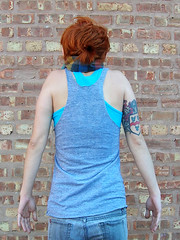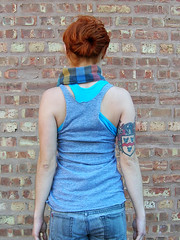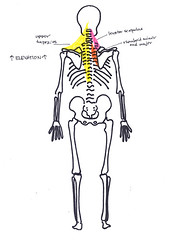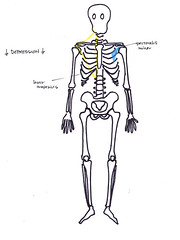So now we're up to:
What movements happen at this joint?
The first two movements at the shoulder girdle that I'm going to talk about are elevation and depression. Elevation is when the shoulder blades go up, as in shrugging your shoulders. Depression is when they come back down. Movements and also muscle groups tend to occur in pairs, basically one to do and the other to undo. So depression isn't so much about pressing your shoulder blades down past their neutral position, though you can a little bit, it's more what goes up must come down and there's muscles to do that.
Huge thanks to shoalmate Zombea Arthur for posing for a hundred and fifty shots of movement at the major joints in a tank top on this sunny but freezing morning. Also see her neckwarmer, that is something that I want to make a few of this season—more about that later.
What muscles make these movements happen?
The muscles in your back that elevate your shoulder blades are the Harry Potter spell of muscles, your levator scapulae, and your rhomboid minor and major and upper trapezius. You can see how that is, right? How the levator scapulae when it contracts—which is how muscles work— will pull the shoulder blade up? Same for the rhomboids? Some part of the upper rhomboid is the rhomboid minor and some part of the lower rhomboid is the rhomboid major, I'm not exactly sure where one ends and the other begins. The book says they're functionally the same muscle; this is not always the case with muscles named minor and major, sometimes they're totally different muscles that do totally different things. And like your trapezius is such a big muscle that different parts do different things, you can see how the upper trapezius would pull your shoulder blade up.
The muscles that depress your shoulder blades are your lower trapezius in your back, and your pectoralis minor in your chest. It's probably clearest with the lower trapezius, being below the shoulder blade; it contracts, it pulls the shoulder blade down. Whereas the pectoralis minor pulls more at a downward diagonal, but still down.
What exercises make these muscles work?
Once you understand the movements that happen at these joints, you mainly know what exercises that would work the muscles that make those movements happen. You basically make that movement and since what goes up must come down, you make the other movement on the return. Shoulder shrugs elevate the shoulder blades to work the levator scapulae and upper trapezius, and upward rows do more work on the trapezius with a little upward and downward rotation thrown in, which we will get into a couple posts from this. I feel like abduction and adduction are more involved with working the rhomboids, pectoralis minor, and serratus anterior, so onward...



